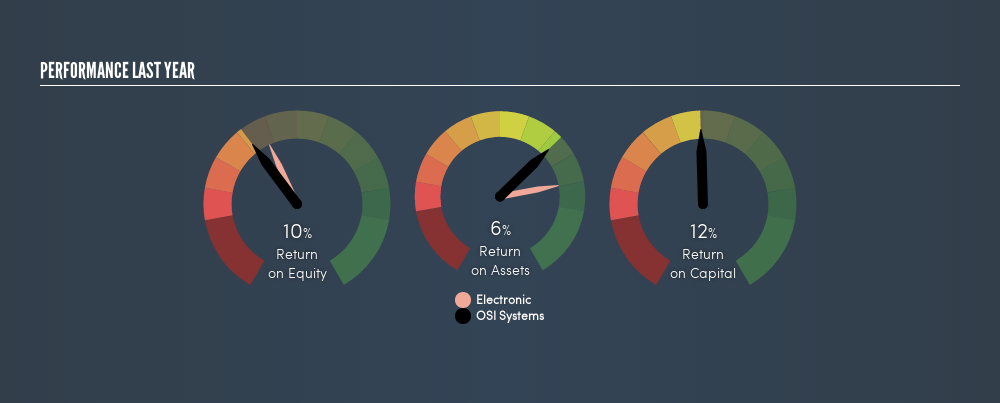- United States
- /
- Electronic Equipment and Components
- /
- NasdaqGS:OSIS
What Can We Learn From OSI Systems, Inc.’s (NASDAQ:OSIS) Investment Returns?

Want to participate in a short research study? Help shape the future of investing tools and you could win a $250 gift card!
Today we are going to look at OSI Systems, Inc. (NASDAQ:OSIS) to see whether it might be an attractive investment prospect. To be precise, we'll consider its Return On Capital Employed (ROCE), as that will inform our view of the quality of the business.
First of all, we'll work out how to calculate ROCE. Then we'll compare its ROCE to similar companies. Then we'll determine how its current liabilities are affecting its ROCE.
Return On Capital Employed (ROCE): What is it?
ROCE measures the amount of pre-tax profits a company can generate from the capital employed in its business. All else being equal, a better business will have a higher ROCE. In brief, it is a useful tool, but it is not without drawbacks. Author Edwin Whiting says to be careful when comparing the ROCE of different businesses, since 'No two businesses are exactly alike.'
So, How Do We Calculate ROCE?
The formula for calculating the return on capital employed is:
Return on Capital Employed = Earnings Before Interest and Tax (EBIT) ÷ (Total Assets - Current Liabilities)
Or for OSI Systems:
0.12 = US$101m ÷ (US$1.3b - US$426m) (Based on the trailing twelve months to March 2019.)
So, OSI Systems has an ROCE of 12%.
Check out our latest analysis for OSI Systems
Does OSI Systems Have A Good ROCE?
When making comparisons between similar businesses, investors may find ROCE useful. We can see OSI Systems's ROCE is around the 12% average reported by the Electronic industry. Separate from OSI Systems's performance relative to its industry, its ROCE in absolute terms looks satisfactory, and it may be worth researching in more depth.

When considering this metric, keep in mind that it is backwards looking, and not necessarily predictive. ROCE can be misleading for companies in cyclical industries, with returns looking impressive during the boom times, but very weak during the busts. This is because ROCE only looks at one year, instead of considering returns across a whole cycle. What happens in the future is pretty important for investors, so we have prepared a free report on analyst forecasts for OSI Systems.
What Are Current Liabilities, And How Do They Affect OSI Systems's ROCE?
Liabilities, such as supplier bills and bank overdrafts, are referred to as current liabilities if they need to be paid within 12 months. Due to the way the ROCE equation works, having large bills due in the near term can make it look as though a company has less capital employed, and thus a higher ROCE than usual. To check the impact of this, we calculate if a company has high current liabilities relative to its total assets.
OSI Systems has total liabilities of US$426m and total assets of US$1.3b. As a result, its current liabilities are equal to approximately 33% of its total assets. OSI Systems has a medium level of current liabilities, which would boost the ROCE.
The Bottom Line On OSI Systems's ROCE
OSI Systems's ROCE does look good, but the level of current liabilities also contribute to that. OSI Systems shapes up well under this analysis, but it is far from the only business delivering excellent numbers . You might also want to check this free collection of companies delivering excellent earnings growth.
If you like to buy stocks alongside management, then you might just love this free list of companies. (Hint: insiders have been buying them).
We aim to bring you long-term focused research analysis driven by fundamental data. Note that our analysis may not factor in the latest price-sensitive company announcements or qualitative material.
If you spot an error that warrants correction, please contact the editor at editorial-team@simplywallst.com. This article by Simply Wall St is general in nature. It does not constitute a recommendation to buy or sell any stock, and does not take account of your objectives, or your financial situation. Simply Wall St has no position in the stocks mentioned. Thank you for reading.
About NasdaqGS:OSIS
Acceptable track record with mediocre balance sheet.
Similar Companies
Market Insights
Community Narratives





